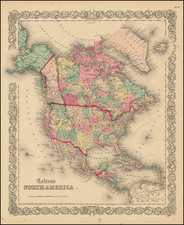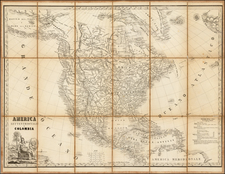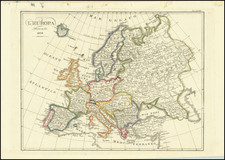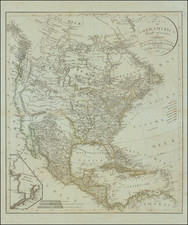Rare Chart of the Atlantic Ocean by William Faden
Impressive William Faden chart of the North Atlantic used to track the voyages of the Royal Navy vessel HMS Hyperion during the War of 1812 and aboard her captain's previous command, HMS Polyphemus, in 1808.
The chart shows the Atlantic north of Bioko Island (Fernando Po) and south of Cape Farewell, Greenland. It is a standout document for visualizing the War of 1812, as it delineates and labels the Royal Navy stations on the east coasts of the Americas. These stations were the primary formations of naval command during the majority of Britain's maritime dominance, including the War of 1812. The stations were an integral component of the geography of the war, and to see such a clear manuscript delineation on a chart is as instructive as it is unusual.
Manuscript Annotations: American Stations and Sea Tracks
The chart shows four British Naval Stations (see below), which were the primary regional commands of the British Royal Navy in the 18th and early 19th Centuries. The Newfoundland Station, colored yellow, covers the waters around Newfoundland and the Canadian coast north toward the Arctic. The North American Station, colored green, covers the coast between the Gulf of St. Laurence and St. Augustine, Florida, as well as a large swath of ocean surrounding Bermuda. The Jamaica Station, colored red, covers Florida and the Caribbean east to the Mona Passage and south to Caracas. The Windward Island Station, centered on Barbados, is colored blue.
The tracks on the map relate to two Royal Navy vessels; the earlier voyage is that of HMS Polyphemus, and the latter is HMS Hyperion.
In 1808 (the year after the chart was published), a manuscript track records HMS Polyphemus leaving Cornwall with a convoy on July 7th, and arriving in Madeira on the 26th of that month ("Polyphemus & Convoy to Madeira 1808.") From there, she and the convoy leave Madeira on August 3rd, headed to the West Indies and arriving in Barbados on August 29th ("His Majesty's Ship Polyphemus with Convoy to the West Indies 1808.")
HMS Hyperion first appears on December 14, 1811, sailing from Tortolas, Florida (south of Cape Canaveral) to England, arriving off the Scilly Isles on January 18, 1812 ("His Majesty's Ships Hyperion from Jamaica and Vera Cruz to England December 1811 and January 1812"). Later that year, on May 17, 1812, she again appears off the Scilly Isles headed toward Bellisle, Newfoundland, where she arrives on June 9 ("Hyperion to Newfoundland and Davis Straits 1812"); from there, she cruises north off the chart to the Davis Strait (for the protection of the whaling fleet active there), reappearing on August 15, 1812, headed south to St. John's. Newfoundland, where she arrives on September 4th ("Hyperion from Davis' Straits to Newfoundland 1812"). Hyperion leaves St. John's on October 17th, headed toward Barbados with a convoy, arriving there on November 7th or 8th ("Hyperion & Convoy from Newfoundland to Barbadoes 1812"). On November 18, 1812, she leaves Barbados, heading toward Newfoundland, where she arrives on December 12th ("Hyperion from Barbados to Newfoundland 1812"). From there, she leaves on an undated voyage (she was frozen up for four months in that harbor during the winter of 1812) and, perhaps chasing a prize, cruises circuitously off Portugal before heading back to the English Channel.
Captain William Pryce Cumby
Based on the voyages depicted, we can deduce that the map was probably owned by Captain William Pryce Cumby or one of his officers. Cumby captained Polyphemus from 1808 to 1811 and Hyperion from 1811 to 1815. Cumby rose to prominence after the Battle of Trafalgar, during which he took command of Bellerophon when Captain John Cooke was killed by French fire. Then-Lieutenant Cumby distinguished himself by leading a counterattack and capturing the French vessel Aigle from which the attack that killed Cooke had come.
Cumby was declared a hero after the battle, made Post Captain, and given command of another Trafalgar veteran, HMS Polyphemus. With Polyphemus, he engaged in multiple raids in the Caribbean. He also commanded the squadron that blockaded and captured San Domingo.
Crumby protected the Davis Strait whale fisheries during the War of 1812 and served on convoy duty in the Atlantic during this time as well (both shown on the present chart).
Crumby was given several less dangerous commands later in his career, including of the Royal yacht HMY Royal Sovereign, and later, he was Superintendent of Pembroke Dockyard but died shortly after taking that office. His tomb reads:
Here lie The Mortal Remains of Captain William Pryce Cumby, R.N., C.B. Of H.M. Yacht Royal Sovereign And Captain Superintendent of Pembroke Dock Yard An Officer Whose zeal and professional services At Trafalgar and St. Domingo Deserved and received the approbation Of his Country His active kindness in promoting the welfare of others procured him the affectionate regard Of all who knew him The loss of one so kind and good Has taught his relations and friends How vain is every consolation But that afforded by Religion By Christian submission By Christian Hope Born XXth March MDCCLXXI Died XXVIIth September MDCCCXXXVII
Rarity
The chart is rare on the market, and seemingly unique with the current color scheme.
British Naval Stations
Jamaica Station was formed by British Navy as a regional command in 1655, it existed as a separate station until 1830, when it was merged into the North American Stations. Formed after the capture of Jamaica, it initially consisted of about 12 frigates, under the command of Sir. William Penn, father of the William Penn who founded the Province of Pennsylvania.
North American Station was founded in 1745. Headquartered in Halifax, it was formed to counter the French presence in the region, but was not formally named the North American Station until 1767. It served as the main base for the Royal Navy in North America during the Seven Years' War, the American Revolution, and the French Revolutionary Wars. From 1758, a headquarters was also established in Bermuda, which served as the primary base of operations during the Chesapeake Campaign and the War of 1812, during which time the British imposed a blockade on US Maritime Trade, commencing in the aftermath of the Chesapeake-Leopard Affair.
Newfoundland Station was formed by the British Royal Navy in 1729 and lasted until 1825, as a means of protecting the British fishing fleet operating in the region. It typically involved a squadron of military ships sent out to protect convoys of fishing vessels operating in the region. Initially based in Portsmouth and/or Plymouth, a permanent headquarters was established in St. Johns in 1818.
Windward Island Station is a name which seems to have been occasionally used to describe the Leeward Islands Station (also called the Barbadoes and Leeward Islands Station). Formed in 1743, the Leeward Island station was formed by the British Navy as a separate command from the Jamaica Station to protect Britain's sugar producing islands and its convoys. Headquartered in Antigua, the station was active until 1821, when it was consolidated into the North America Station. The name Windward Island Station seems to appear most often after the American Revolution, and in fact is referenced in an account of the capture of 2 French ships by the HMS Pompee, aided by several other ships, including HMS Polyphemus in April, 1809, off the Îles des Saintes, part of the Guadalupe archipelago.
William Faden (1749-1836) was the most prominent London mapmaker and publisher of the late-eighteenth and early-nineteenth centuries. His father, William Mackfaden, was a printer who dropped the first part of his last name due to the Jacobite rising of 1745.
Apprenticed to an engraver in the Clothworkers' Company, he was made free of the Company in August of 1771. He entered into a partnership with the family of Thomas Jeffreys, a prolific and well-respected mapmaker who had recently died in 1771. This partnership lasted until 1776.
Also in 1776, Faden joined the Society of Civil Engineers, which later changed its name to the Smeatonian Society of Civil Engineers. The Smeatonians operated as an elite, yet practical, dining club and his membership led Faden to several engineering publications, including canal plans and plans of other new engineering projects.
Faden's star rose during the American Revolution, when he produced popular maps and atlases focused on the American colonies and the battles that raged within them. In 1783, just as the war ended, Faden inherited his father's estate, allowing him to fully control his business and expand it; in the same year he gained the title "Geographer in Ordinary to his Majesty."
Faden also commanded a large stock of British county maps, which made him attractive as a partner to the Ordnance Survey; he published the first Ordnance map in 1801, a map of Kent. The Admiralty also admired his work and acquired some of his plates which were re-issued as official naval charts.
Faden was renowned for his ingenuity as well as his business acumen. In 1796 he was awarded a gold medal by the Society of Arts. With his brother-in-law, the astronomer and painter John Russell, he created the first extant lunar globe.
After retiring in 1823 the lucrative business passed to James Wyld, a former apprentice. He died in Shepperton in 1826, leaving a large estate.









![Europa Vetus [Ancient Europe]](https://storage.googleapis.com/raremaps/img/small/82034.jpg)

![[ Atlas of Africa ] L'Afrique en Plusieurs Cartes Nouvelles, et Exactes; &. En Divers Traictes de Geographie, et D'Histoire.](https://storage.googleapis.com/raremaps/img/small/68986.jpg)


